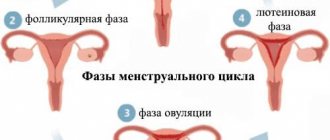Hypomenorrhea - menstrual dysfunction
Normally, a regular menstrual cycle should be established a maximum of 12 months after menarche (first menstruation).
All its violations that occur after this period are a sign of pathology. Scanty periods - or hypomenorrhea - is one of the menstrual dysfunctions. But depending on the age of the woman, the reasons for scanty periods will be different; these disorders can be not only pathological, but also absolutely physiological. This happens at the very beginning of the development of a woman’s menstrual function, in adolescence, when the first menstruation, menarche, has already passed, but the cycle has not completely established itself. A girl has a whole year to establish a cycle, during which menstruation can be not only scanty, that is, small in volume - less than 50 ml, but also rare, for example, like opsomenorea, when the cycle lengthens to 5-8 weeks; Menstrual flow may be short and last less than two days (oligomenorrhea). Menstruation can even be extremely rare (spaniomenorrhea), occurring only 2–4 times a year. But all these disorders must necessarily disappear after one year (maximum two years) from the moment of the first menstruation. If this does not happen, and the cycle remains irregular and acyclic, then we can safely talk about the pathology of menstrual function.
Scanty menstruation, in a completely physiological sense, can also occur during the decline of a woman’s reproductive function, in the premenopausal period. This period precedes the complete cessation of menstruation - menopause, and lasts about 2 years. Physiological hypomenorrhea during these most important periods of a woman’s life is possible, but this does not mean that it will necessarily be present in everyone. In addition, we cannot exclude the presence of pathological hypomenorrhea, for various reasons, in these same two age periods, although this happens much less frequently.
Pathologically scanty menstruation, for ease of diagnosis, is divided into:
- primary hypomenorrhea, when, in fact, there was not a single normal menstruation. This is observed in teenage girls.
- secondary hypomenorrhea, when menstruation was absolutely normal for some time, and then impoverishment occurred, which became the cause of the woman’s anxiety.
Symptoms
The manifestations of hypomenorrhea are minor and therefore many women do not even suspect that they have this condition. The main, and perhaps the only symptom, is a decrease in the amount of menstrual blood released to 50 ml. The discharge may appear as bright red beads on your underwear, or as dark brown, dirty red streaks. In the absence of proper attention to the state of your health, such discharge may not be mistaken for menstrual discharge at all.
Hypomenorrhea
, like other forms of pathological menstruation, can be accompanied by deterioration in health, malaise, headaches, even chest pain. Nausea, even vomiting, may also occur; nosebleeds of varying intensity, and disorders of mental and neurological well-being. But the most common symptoms accompanying hypomenorrhea are pain in the lower abdomen, quite intense, spastic in nature, like twisting; aching pain in the lower back, often bilateral, as well as a decrease in libido, which occurs due to a drop in the level of estrogen in the blood.
What diseases can be the cause?
They can be released according to the menstrual schedule, and then it is considered that menstruation is occurring. However, such symptoms may be signs of diseases that do not manifest themselves in any way at the beginning. This is possible with the following pathologies:
- tumors of the ovary or uterus
- hormonal imbalance
- polycystic ovary syndrome
- pituitary tumor (responsible for the functioning of female organs).
With a high probability we can talk about any disease when the following conditions appear:
1. Your breasts are swollen, your stomach hurts, and your period is not coming.
2. The color of bleeding after childbirth has changed, it has become scanty, color: brown, dark brown, black.
3. Scanty bleeding is accompanied by pain in the lower abdomen, the chest is not swollen and does not hurt.
4. The amount of blood decreases in volume every month.
Causes
Often the cause of hypomenorrhea is the low weight of a girl (since estrogens accumulate in fats).
To identify specific causes of scanty periods
(that is, the development of hypomenorrhea), it is necessary to determine whether it belongs to the primary form or is secondary. The occurrence of primary hypomenorrhea is associated with congenital developmental anomalies, including the genitals, and various mental development delays. But most often, at present, in this case the cause is the girl’s insufficient or even critically low body weight. This connection occurs at the hormonal level, since estrogens, for the most part, are deposited in adipose tissue.
The causes of the secondary form of hypomenorrhea include many factors. If we talk about mechanical factors, then this is the presence of a pathological narrowing of the cervix, which simply does not allow spilled blood into the vagina, as well as previous injuries and operations on the pelvic organs, including the genitals. Another group of reasons is the development of endometrial inferiority when its area decreases after surgical removal of part of the uterus, or when the number of hormone receptors on its surface decreases due to excessive curettage, or during long-term and severe inflammatory processes. Another large group of causes is diseases of the endocrine system, and, as a consequence, disruption of the hormonal regulation of menstrual function. Weight fluctuations, as the cause of the primary form of hypomenorrhea, can also be safely attributed to these reasons. As well as stress, emotional overload and lack of vitamins in the food consumed. The use of oral contraceptives by a woman can also significantly lead to the impoverishment of menstruation.
Treatment
For any form of hypomenorrhea, you must seek help from an obstetrician-gynecologist. Even if a woman is sure of the cause of scanty periods, and believes that she can cope with this problem on her own, restoring the cycle, additional diagnostics, including differential ones, are necessary. Treatment of hypomenorrhea comes down to eliminating the causes that caused it.
Scanty periods are a menstrual disorder characterized by very scanty menstrual bleeding, in which the amount of blood released is significantly less than the physiological norm (less than 50 ml). In medicine, this condition is called hypomenorrhea.
In most cases, hypomenorrhea is accompanied by oligomenorrhea (decreased duration of menstruation) or precedes its complete absence (amenorrhea). Also, scanty periods may indicate the presence of various pathologies of the female genital area or be a physiological condition (premenopause or the formation of menstrual function).
There are two types of pathological scanty menstruation:
- primary hypomenorrhea, which is observed in teenage girls during a period when, in fact, there has not yet been a single normal menstruation;
- secondary hypomenorrhea, which occurs after a period of completely normal menstruation.
Causes of weak menstruation
Below are the most common factors that may cause your menstrual bleeding to be lighter than usual.
Age
The strength of the flow of menstrual blood may vary in different years of a woman’s life. At a young age, weak periods are usually observed, which are sometimes manifested by minor bleeding. In your twenties and thirties, periods tend to become more regular.
In the late thirties and early forties, the flow of menstrual blood may increase noticeably. During this time, women sometimes experience periods where one month there is no menstruation, and four weeks later there is heavier bleeding than usual. During perimenopause, periods tend to become lighter and less regular.
Lack of ovulation
Sometimes women suffer from menstrual irregularities due to the fact that the body does not release an egg. This phenomenon in the medical world is commonly called anovulation. Anovulation can cause weak menstrual blood flow.
Lack of weight
Women who are underweight may notice that their periods become very light or stop altogether. This occurs when body fat levels drop to a critical level, causing a woman to fail to ovulate regularly.
Excessive physical activity is another reason for missing periods and can also lead to weight loss.
Reasons for scanty periods
A number of factors can trigger the mechanism for the development of scanty periods. These include: dysfunction of the ovaries or pituitary gland during reproductive age, inferiority of the endometrium in the uterine cavity as a result of inflammatory diseases or intrauterine manipulations, disruption of the cyclic production of hormones.
In gynecology, the following are the most common causes of scanty periods:
- stress, overload, neuropsychiatric diseases;
- sudden weight loss as a result of grueling physical activity, depleting diet, anorexia;
- chronic endometritis, which is an inflammation of the uterine mucosa caused by abortion, surgery, and the use of an intrauterine device over a long period of time;
- pregnancy. In some cases, scanty periods can be observed in the first month of pregnancy, if this is not a sign of a threat of miscarriage;
- the use of hormonal contraception prevents the growth of the endometrium, and, as a result, its detachment does not occur;
- premenopause. Menstrual phenomena before menopause may decrease to a minimum;
- infectious diseases, including tuberculosis;
- lactation period. During breastfeeding, lactational amenorrhea often occurs. After some time, menstruation may resume, but until lactation stops, its character may be different;
- effects on the body of chemicals and radioactive radiation, climate change;
- diseases of the thyroid gland and adrenal glands, diabetes mellitus, obesity, lack of vitamins;
- insufficient puberty, abnormal development of the uterus and its appendages.
Causes of hypomenorrhea
Among the main reasons for scanty periods are changes in the ratio of hormones in the body, which occurs as a consequence of natural processes (the formation and decline of sexual function), gynecological or endocrine pathologies, the use of hormonal drugs for treatment or contraception.
Recommendation: If hypomenorrhea occurs during the use of contraceptives for more than 2 months in a row, then it is necessary to select other means.
In addition, there are other reasons for scanty periods:
- Thyroid diseases. The hormones produced in this gland directly affect the formation of estrogen and the functioning of the reproductive organs. Disturbances in the functioning of the thyroid gland cause the egg to not mature and be unable to leave the follicle (protective capsule). When estrogen levels are low, the uterine lining does not have time to develop. She is too thin for full periods.
- Excessive body weight or excessive thinness. Estrogen production occurs in adipose tissue, just like in the ovaries. In obese women, this accumulation leads to an excess of hormones. The lack of adipose tissue in women who are too thin leads to their lack. In both cases, hormonal disorders appear, which affect the condition of the reproductive organs.
- Scanty periods (up to complete disappearance) occur with anorexia. In addition, the cause of the pathology is sudden weight loss after a special diet or forced fasting.
- Anemia, vitamin deficiency. Without micro- and macroelements, as well as vitamins, the production of hormones in the body and normal metabolism are impossible. Hematopoiesis is disrupted. Exhaustion of the body inevitably affects reproductive abilities, leads to infertility, and the occurrence of cancerous tumors.
- Damage to the genital organs during childbirth, abortion, curettage, leading to changes in tissue structure that interfere with the normal course of the menstrual cycle. If, after cleaning the uterus, your periods become scanty and the discharge has an unpleasant odor, then sometimes you have to do a second curettage, since, most likely, particles of the lining remain in the uterine cavity or an infection has occurred.
- Congenital abnormal development of the genital organs, partial removal of the uterus.
- Physiological processes associated with hormonal changes in the body (pregnancy, lactation, menopause).
- Increased physical and neuropsychic stress, working with harmful chemicals, unfavorable environment.
Video: Reasons why scanty brown periods appear
Scanty periods during pregnancy
Pregnancy occurs if, after the egg has matured in the 2nd half of the menstrual cycle, it is fertilized. During the period of maturation, the ovaries produce the maximum amount of female sex hormones, estrogens. They are also responsible for preparing the uterus to receive the fertilized egg, the growth of the mucous membrane where it should take hold and develop.
Symptoms
Since hypomenorrhea itself is manifested by scanty periods, many women do not even suspect the presence of pathology. Discharge reduced to 50 ml may look like bright red droplets on hygiene products, or smearing traces of dark brown or dirty red color.
Like some other forms of pathological menstruation, scanty periods can be accompanied by a deterioration in general health, headaches, malaise, and chest pain. In some cases, nausea may occur, progressing to vomiting, disturbances in mental and neurological well-being, and nosebleeds of varying intensity.
Most often, hypomenorrhea is accompanied by fairly intense cramping pain in the lower abdomen, bilateral aching pain in the lower back, and decreased libido due to a drop in the level of estrogen in the blood.
Early scanty periods
This condition is often observed in girls during the formation of menstrual function and is a physiological condition, despite the appearance of pain in the sacral region, abdomen, and chest. Since this process is physiological in nature, it does not lead to the development of serious consequences. Early scanty periods in teenage girls are yellow or light brown.
Long, scanty periods
The presence of long, scanty periods in a woman indicates the development of a serious disease of the genital organs or a violation of the hormonal regulation of the menstrual cycle. Delayed diagnosis of this condition can lead to the development of dangerous complications (lack of menstruation, infertility).
Scanty brown periods
The brown color of the discharge indicates certain disturbances in the functioning of the reproductive system. The most common cause of this symptom is chronic endometritis. In turn, various infectious diseases, post-abortion or postpartum endometritis, and intrauterine interventions can lead to this condition. Scanty brown periods are accompanied by aching pain in the lower abdomen and have an unpleasant odor.
Often, brown discharge after menstruation can be caused by the use of hormonal contraceptives.
After taking Duphaston
Since Duphaston is a synthetic analogue of progesterone (the female sex hormone), it is prescribed to treat a number of problems of the female genital area. In some cases, after taking Duphaston, patients experience scanty periods. This is due to the fact that this drug is used strictly according to the regimen prescribed by the doctor. Deviation from the prescribed course leads to imbalance in the menstrual cycle.
Treatment
Treatment of scanty periods depends entirely on the results obtained during the diagnosis. If hypomenorrhea is caused by disturbances in psycho-emotional balance, physical development and nutrition, then therapeutic measures are limited to the correction of these disturbances. If there are certain indications, hormonal drugs, vitamin complexes and specific antimicrobial agents are prescribed.
A good effect in the treatment of scanty periods is achieved by taking homeopathic remedies, as well as psycho- and physiotherapy aimed at eliminating functional disorders.
During premenopause and lactation, no special treatment for hypomenorrhea is required.
Most women jealously monitor their women's health and notice any changes of an intimate nature. However, to preserve your femininity and attractiveness for many years, you need to use not only observation, but also some medical knowledge.
Often, representatives of the fair sex can observe such a phenomenon as menstruation without blood. What does this mean? All the characteristic signs of menstruation (abdominal pain, tension in the mammary glands) are present, but either very little blood flows or only a few drops. This condition is called “hypomenorrhea” and can be a symptom of a chronic menstrual disorder. However, there are other cases when little blood during menstruation is not a deviation. Let's try to figure out how to distinguish one from the other.
There is even a special classification of scanty periods: primary and secondary. The concept of primary hypomenorrhea means that all menstruation, starting from the very first, was exactly like this. That is, the girl did not have any full periods; instead, a few drops of blood came out (periods up to 50 ml in volume are considered scanty). Secondary hypomenorrhea implies that menstruation has always been normal, but at some point there was a failure.
Primary hypomenorrhea
The very first menstruation of a teenage girl (“menarche”) can be anything from heavy to very scanty, when very little blood comes out. The reason for this failure is the formation of a cycle for which a whole year is allocated. During this period, the girl may observe long breaks between critical days, brown “smudge” instead of blood - all this is physiological. But menstruation must return to normal within the allotted time of one year.
If after a year no improvements occur and hypomenorrhea is still observed, all indicators indicate pathological disorders, the treatment of which should be started with great seriousness and responsibility.
Scanty periods after childbirth
Scanty periods after pregnancy are common and should not cause concern.
The fact is that the body recovers after childbirth not immediately, but within five months. During this period, there are no periods, as the body continues to produce progesterone, which prevents a new pregnancy. The first periods after such a long break are usually scanty and short-lived. However, in the next cycle everything should return to normal. If this does not happen, then there is a malfunction in the body. The following factors could provoke it:
- inflammation of the uterus caused by improper stitching of ruptures, rotting of pieces of the endometrium that were not removed in time, or the development of an infection caught during childbirth;
- incorrect functioning of the pituitary gland;
- postpartum depression;
- Stress from breastfeeding.

You should not ignore scanty periods in such a situation, because everything that happens to the mother inevitably affects the child. So, if a woman’s uterus is inflamed, the quality of her breast milk drops, and the baby who consumes it experiences intestinal colic, bloating, belching, and diarrhea. And if the mother is sick, the child can catch an infection from her, against which his body is powerless. That is why it is important not to delay a visit to the hospital during scanty menstruation - the health of not only the woman herself, but also her newborn child is at risk.
Secondary hypomenorrhea
For every woman at different ages, the time comes for the complete cessation of menstruation. This phenomenon is called menopause, and its reasons lie in the gradual change in hormonal levels. This is why a woman after menopause can no longer have children.
For some time before menopause, menstrual irregularities may occur. Women especially often complain about hypomenorrhea, in which very little blood comes out during menstruation.
Also, hypomenorrhea can occur during childbearing age due to illness or severely reduced immunity, exhaustion during diets.
Symptoms of scanty periods
Hypomenorrhea can manifest itself so inexpressively that a woman will not even think that she has had her period. The decrease in the amount of blood can be very strong and instead of menstruation, only a few bright red drops will come out. In some cases, instead of blood, only a dark brown “smudge” comes out, which also indicates pathology. Doctors have approved a limit of 50 ml - this is the total amount of blood released during menstruation. If the indicator is lower, this immediately suggests hypomenorrhea.
It is important to very carefully observe all manifestations of menstruation and compare them with your own cycle calendar. If it is time for menstruation and only scanty discharge appears, then we can talk about pathological hypomenorrhea.
For more accurate self-diagnosis, you should know that scanty periods also affect the general condition of the female body, the reasons for this again lie in the hormonal background. Often women experience severe aching pain in the abdomen, which is in the nature of cramps, and pain in the lower back. Less commonly observed are nausea, vomiting, spontaneous nosebleeds, irritability and lethargy. Due to a decrease in the amount of estrogen in the blood, the level of sexual desire most often decreases.
Scanty periods in teenagers and pregnant women
Scanty periods are often observed in adolescents who have entered puberty.
Bloodless menstruation - they received this name due to their insignificant volume and characteristic pinkish, rather than bright red, hue.
Also, discharge of a similar nature occurs in pregnant women. In this case, they act as an alarm signal, warning of a failure in the process of formation and development of the fetus, fading of pregnancy, or the onset of spontaneous miscarriage. In some cases, scanty periods occur after pregnancy. This happens when the egg is fertilized exactly on the eve of the critical days. In both adolescents and pregnant women, discharge during menstruation may be characterized by a lack of color, indicating an inflammatory process in the pelvis, or a brown tint, signaling damage to the uterus. In both cases, you cannot hesitate: you should immediately see a doctor in order to avoid the development of dangerous pathologies.
Why does hypomenorrhea occur?
To make an accurate diagnosis, you need to find out from the very beginning which category the disorder belongs to: primary or secondary. Primary hypomenorrhea is most often associated with pathologies of the development of the pelvic organs in girls and congenital anomalies.
Another important reason is the reduced amount of estrogen, which accumulates in the fatty tissues of the body. It happens that the menstrual cycle is disrupted due to strict diets or extreme weight loss. Scientists note a strong relationship between the mental development of a teenage girl and the development of her hormonal levels. If children are mentally retarded, then most likely they will have problems with their cycles.
Secondary hypomenorrhea involves more diverse causes: a pathologically narrowed cervix (it cannot let blood through), various postoperative complications, trauma after childbirth.
The usefulness and health of the endometrium plays a very important role: after removal of part of the uterus or severe curettage, it can become much less sensitive to hormones.
It has a very bad effect on the menstrual cycle and endocrine ill health. If a disorder of one of the glands develops and, accordingly, the level of hormones in the blood changes, the consequences can be serious. Therefore, during the course of such diseases, it is necessary to regulate hormonal levels with medications.
A woman must ensure that she gets enough sleep and eats enough vitamins. Such seemingly simple factors can greatly affect the general condition of the body, including menstruation.
A stable menstrual cycle is an indicator of the health of a woman’s reproductive system. Any deviations from the norm in it are a cause for concern. One of the variants of pathology is short periods. In a healthy woman of reproductive age, menstrual flow lasts for 3 days. Their maximum duration is a week. Sometimes there is a shortening of the discharge period. It can last 1 or 2 days. This phenomenon is called oligomenorrhea. Sometimes this can be normal, but more often than not, the fact that your period ends prematurely indicates problems in the body.
Menstruation lasting 1-2 days is considered short.
Short menstruation without pathology
The duration of menstrual flow is individual for each woman. If your periods have become shorter for no apparent reason, then you need to visit a gynecologist unscheduled.
However, there are a number of cases when short menstruation is normal:
- Light discharge on the days of your expected period may indicate pregnancy. They can last 1–2 days. The hormonal background in the early stages of pregnancy has not yet changed, so scanty and short menstrual flow may be observed. There may be implantation bleeding. It is initiated by the process of implantation of the embryo into the wall of the uterus.
- After childbirth, hormonal changes begin in the body. During the period of active lactation, physiological amenorrhea is observed before the introduction of complementary foods. Gradually, hormonal levels return to normal, but in the first months, menstrual flow may be unstable.
- After an abortion, short periods may indicate the development of complications after the operation. This is evidenced by the dark color of the discharge, an unpleasant odor and an increase in the woman’s temperature.
- A girl's first period during puberty can also end quickly. This may continue until the cycle is completely established.
- During menopause, a woman may experience a short menstrual cycle. This is due to the gradual decline of reproductive function.
If menstrual flow ends quickly under other circumstances, you should consult a doctor.
Short periods may indicate pregnancy
When short periods are normal
Regular periods are evidence of a healthy reproductive system. Any changes in the duration or volume of discharge become a signal for a visit to the doctor.
The duration of a normal menstrual cycle is from 21 to 35 days, up to six of which there are lochia, the volume of fluid lost is no more than 80 ml.
When it comes to short menarche, it does not only mean reducing the volume of discharge to 50 ml or less. The number of days in the cycle also decreases (to 21 days or less).
The reason for the shift may be:
- premature maturation of the egg;
- general weakening of the body due to sudden weight loss;
- decreased immunity.
However, before saying that short menstruation is a deviation, you should understand when such a condition fits within the norm.
- Early pregnancy - hormonal levels at this stage have just begun to change; the woman notes that the volume of monthly discharge has decreased, and its total duration has decreased.
- Restoring the cycle after lactation. If amenorrhea (complete absence of menstruation) is observed during breastfeeding, then for the first time after adding complementary foods or stopping breastfeeding. Not only slight discharge may be observed, but also a decrease in days with discharge compared to the prenatal period.
- Hormonal changes during puberty or menopause. For young girls, the formation of a cycle is typical up to a year after the start of the first menstruation, that is, we cannot talk about any systemic failures. During menopause, reproductive function declines.
Any of the listed conditions is normal and does not require an immediate visit to the doctor. If other signs are detected, you should consult a doctor.
Signs
Pathological oligomenorrhea is characterized by low blood loss. The total volume of discharge does not exceed 50 ml. Menstrual flow lasts up to two days.
Oligomenorrhea may be primary. This means that menstruation never lasted more than two days.
With secondary oligomenorrhea, against the background of normal menstruation, a sudden shortening is observed.
If your period ends earlier than expected, this may indicate the presence of a disease in the reproductive system. In addition to the fact that the volume of discharge has become less, additional symptoms may be observed, such as:
- migraine;
- weakness;
- nausea;
- soreness of the mammary glands;
- nosebleeds;
- pain in the lower abdomen;
- stool disorders;
- decreased libido.
In some cases, only a few of these symptoms may be present. Sometimes oligomenorrhea is not accompanied by any other symptoms.
Nosebleeds may be associated with short periods
Scanty and heavy periods
If the menstrual cycle does not cause pain and deviations in duration (no shorter than 20 and no more than 35 days), amount of discharge (no less than 50 and no more than 150 ml) and cyclicity, then it is considered normal. Usually during menstruation, a woman feels aching and pulling pain in the lower abdomen, but this is normal for this process.
According to doctors, every woman should know the frequency of her menstrual cycle in order to promptly respond to any changes in the normal functioning of the body. To do this, you need to keep a calendar, where you should mark the start and end dates of menstruation, the degree of bleeding.
Scanty and infrequent discharge, absence of menstruation or, conversely, prolonged and heavy discharge, as well as uterine bleeding not associated with the menstrual cycle, are symptoms of a number of gynecological diseases. If such phenomena recur, a woman should urgently consult a doctor.
Thus, oligomenorrhea refers to menstrual disorders characterized by scanty and rare bleeding. In this case, menstruation occurs less frequently than once every 35 days. This disorder is accompanied by the growth of unwanted body hair and weight gain, which indicates ovarian dysfunction.
Causes
Menstruation in 2 days can be provoked by internal reasons, such as congenital structural features of the internal reproductive organs. However, most often oligomenorrhea is a consequence of the influence of external factors. The main ones are:
- weight loss as a result of a strict diet;
- past infectious diseases;
- surgical intervention;
- nervous tension, stress;
- intoxication of the body;
- taking hormonal contraceptives;
- pathologies of the endocrine system;
- metabolic disorders.
The total duration of the menstrual cycle and the length of each of its phases is coordinated by the hypothalamic-pituitary system. These structures are responsible for the smooth functioning of the ovaries. With insufficient production of sex hormones, the duration of menstruation may become shorter.
If menstrual flow ends quickly, then it is likely that the concentration of prolactin or male sex hormones - androgens - in the blood of women will increase. The causes of this phenomenon may be diseases such as adrenogenital syndrome or polycystic ovary syndrome.
If the volume of discharge has become smaller and its duration has decreased, then the cause may be pathologies of the endometrium of the uterus. This is a serious violation that requires specialist supervision. An ignored problem is fraught with impaired reproductive function. The endometrium is the inner layer lining the uterus. It is in it that the fertilized egg is implanted. Oligomenorrhea often indicates that this layer has become thin. This occurs due to insufficient intake of fats into the body.
Taking hormonal contraceptives can lead to oligomenorrhea
Why is there little blood during menstruation, reasons for scanty discharge during menstruation
As practice shows, every tenth woman encounters such a phenomenon as scanty periods (hypomenorrhea). At the same time, half of those who consulted a doctor have a complication such as oligomenorrhea (too short menstruation), usually preceding amenorrhea - the complete absence of menstrual periods. In order to understand where these pathologies come from, it is necessary to turn to female physiology, to consider the processes that occur in the body of representatives of the fair half of humanity before, during and after menstruation.
The duration of the menstrual cycle and the volume of monthly discharge depend mainly on how a woman’s ovaries and brain work (more precisely, one of its parts is the pituitary gland). If these organs function normally, menstruation comes regularly, and during menstruation, just enough blood is released to cleanse the uterus of excess endometrium. If a woman often resorts to diagnostic curettage or periodically has an abortion, the body experiences severe stress, against the background of which the work of the pituitary gland and ovaries may be disrupted, which is fraught with the impoverishment of menstruation, or even their complete cessation. A similar result can be caused by a disease of the reproductive organs of an inflammatory or infectious nature, weakened immunity, stress, radiation exposure, exacerbation of chronic diseases, unhealthy lifestyle, head or abdominal injury, cancer.
These factors can affect the speed of processes that regulate menstrual activity, or even “freeze” them, thereby creating a lot of problems. For example, provoke a decrease in the production or untimely release of female sex hormones responsible for the maturation and rejection of the egg, which is fraught with physiological infertility, polycystic ovary syndrome, endometriosis and various types of disorders in the menstrual cycle.
Diagnosis and treatment
If menstruation ends too quickly, the woman should visit a gynecologist. He will prescribe a series of tests that will help find out the cause of the failure of the female cycle. As a rule, it is proposed to undergo the following examinations:
- blood test to determine hormone levels;
- smear to determine microflora;
- cytological analysis;
- diagnostics by PCR method;
- urine test for hormones;
- measurement of basal temperature;
- endometrial biopsy;
- Ultrasound of the pelvic organs.
Based on a gynecological examination, data from tests and studies, as well as the patient’s complaints, the doctor will determine what causes the shortening of menstrual flow and prescribe treatment.
To lengthen menstruation, it is necessary to eliminate factors that negatively affect the body. If nutritional disturbances are identified, dietary adjustments will be required. Strict diets for oligomenorrhea are strictly prohibited. The body must receive sufficient amounts of all nutrients from food. Lipids play a special role. It is the fat layer that tends to accumulate estrogens. With insufficient amounts of lipids, a decrease in the concentration of female sex hormones is observed, which can lead to a reduction in the duration of menstruation. For general strengthening of the body, the doctor will select a vitamin complex.
Therapy for oligomenorrhea is aimed at establishing a woman’s normal hormonal levels. For this purpose, homeopathic medicines are often prescribed. Their components of plant origin bring the concentration of certain sex hormones to normal. Hormel drops have proven themselves well.
If menstrual flow quickly ends due to endometrial pathology, the doctor will prescribe special medications aimed at restoring it. Usually these are injections of estradiol. To maintain sufficient thickness of the inner layer of the uterus, products such as Utrozhestan or Duphaston are often recommended.
Physiological oligomenorrhea does not require treatment, but observation by a specialist will not be superfluous. Do not neglect preventive measures. Physical activity should be moderate. You should avoid stress and eat right.
In women, the determination of its duration is individual. Any deviations from the norm, which include short menstruation, can be the result of a wide range of effects:
- external factors (mechanical damage, surgery, infectious diseases);
- internal changes (physiological, hormonal, emotional).
Short periods are usually characterized by low blood loss, not exceeding 50 ml per day, and last up to 2 days. Doctors call this process the concept of oligomenorrhea and attribute it to the pathology of menstrual function. If menstruation lasts 3 days, this is normal; a shorter duration during reproductive age is considered a deviation from the norm.
A decrease in the duration of critical days may not cause concern only in the first year of the onset of menstruation and several years before the onset of menopause. A rare occurrence can occur in every woman, since the hormonal and emotional background is constantly changing. Don't forget about pregnancy and the body's recovery period. In other cases, doctors divided scanty and short menstruation into types:
- primary hypomenorrhea (menstruation never exceeded 1–2 days);
- secondary hypomenorrhea (menstruation was within normal limits and decreased sharply without recovery).
Read in this article
Drug treatment of pathology
If the volume of discharge has decreased and your periods are less than usual without objective reasons, you should visit a gynecologist. After the examination, the doctor will prescribe a series of laboratory tests for the woman. Based on their results, it will be possible to determine the cause of the menstrual cycle disruption and select adequate treatment methods. You will need to undergo an ultrasound of the uterus and ovaries.
If the examination reveals disturbances in the functioning of the endocrine glands, the woman is prescribed hormonal therapy. This treatment is designed to normalize the functioning of the ovaries and regulate the menstrual cycle. Gradually, the amount of blood during menstruation should stabilize.
Gynecologists usually prescribe estrogen or progestin. The choice of drug depends on the concentration of sex hormones in the woman’s blood. The duration of the course is 3–6 months.
In some cases, hormonal contraceptives, selected taking into account the individual characteristics of the woman, help restore the normal menstrual cycle.
Doctors often give preference to drugs of natural origin that can stabilize hormonal levels. The drugs Qi-Klim and Estrovel have good reviews.
If a woman regularly experiences scanty menstruation, then it is necessary to take vitamins to maintain the health of the whole body at a high level.
When the volume of menstrual blood decreases due to the presence of infection in the body, it is necessary to treat the provoking factor itself. In some cases, antibiotics or agents with anti-inflammatory effects may be prescribed.
If menstruation is accompanied by severe pain, the doctor will recommend taking analgesics. You can use drugs such as Bral, Baralgin, Analgin, Spazmalgon. No-shpa or Papaverine relieve spasms well.

Estrovel is often prescribed for scanty periods.
Etiology
The ovaries and pituitary gland are responsible for the formation of the menstrual cycle. When menstruation ends prematurely for no apparent reason, functional disorders can be suspected. If curettage has been performed repeatedly or the woman has had tuberculosis, physiological abnormalities may begin, such as inferiority of the endometrium of the uterus. They can provoke a decrease in the period of critical days. Poor blood circulation in the uterus and decreased production also affects the formation of the menstrual cycle. All these deviations indirectly form the number of days in the cycle.
Oligomenorrhea can be caused directly by:
- sudden loss of body weight (starvation, anorexia);
- metabolic disorders and vitamin deficiency;
- nervous overstrain, mental illness;
- surgical intervention in the genitourinary system, injuries of the pelvic organs;
- pathology of the genital organs;
- diseases of the endocrine system;
- infectious diseases;
- intoxication.
Symptoms
Sometimes a woman does not notice any symptoms that could cause concern if.
Most often, light marks are observed on the underwear, which can be mistaken for daily vaginal discharge. If this happened once and was not accompanied by any symptoms, then there is no need to worry.
If the cycle and its duration are violated, the following may appear:
- migraine and headache;
- and weakness;
- aching pain in the lower back and lower abdomen;
- disorders of stool and digestion;
- discomfort in the chest;
- regular nosebleeds;
- decreased sex drive.
The most common symptom of oligomenorrhea is when menstruation occurs one day later. Small ones can be caused by a different range of diseases and developmental disorders. Therefore, to treat menstrual irregularities, it will be necessary to establish the cause of this symptom.
Symptoms and signs of hypomenorrhea
Scanty periods observed over the course of one or two cycles are not yet a reason to consult a gynecologist.
But if the spotting is regular (for three or more cycles), and is accompanied by the following symptoms, it is better to rush to the hospital:
- reducing the number of critical days from five to seven to one or two;
- headache of a throbbing, shooting or bursting nature;
- nausea, sometimes turning into vomiting;
- severe pain in the lower back;
- disruption of the process of digestion and elimination of waste;
- discomfort in the chest;
- decreased or complete absence of sexual desire.
The presence of these symptoms indicates that a serious malfunction has occurred in the body, which cannot be eliminated without the help of a specialist.











